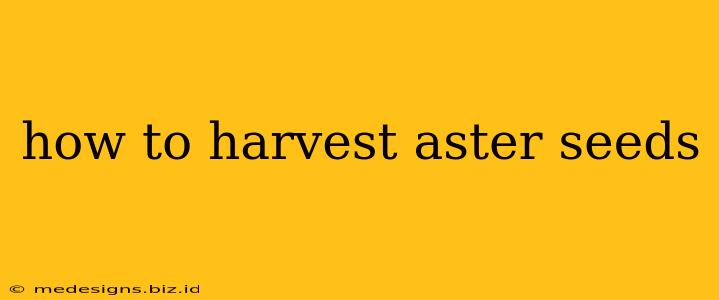Asters, with their vibrant blooms and late-season beauty, are a beloved addition to any garden. But did you know that harvesting their seeds is a rewarding way to expand your aster collection and save money? This guide will walk you through the process of successfully harvesting aster seeds, ensuring you have plenty for next year's planting.
Identifying Mature Aster Seeds
Before you even think about harvesting, you need to know what you're looking for. Mature aster seeds are ready for collection when the flower heads have completely dried and turned brown. This usually happens several weeks after the last blooms have faded. The seed heads will feel dry and brittle to the touch. Don't rush this process! Premature harvesting will result in seeds that won't germinate.
Signs of Seed Maturity:
- Brown Flower Heads: The vibrant colors of the aster will have completely faded to a dull brown or tan.
- Brittle Texture: Gently touch the flower head; it should feel dry and crisp, not soft or moist.
- Seed Dispersal: Some aster varieties will start to naturally disperse their seeds. If you see seeds scattering, it's a sign they're ready for harvest.
Harvesting Aster Seeds: Step-by-Step
Once you've identified mature seed heads, it's time to harvest. Here's a simple method:
- Choose a Dry Day: Harvesting on a dry day prevents the seeds from becoming moldy.
- Cut the Flower Heads: Use sharp scissors or pruning shears to carefully cut the dried flower heads from the plant, leaving a short stem attached.
- Air Drying: Place the cut flower heads in a paper bag or a well-ventilated container. Allow them to dry completely for several weeks in a cool, dry place.
- Seed Extraction: After several weeks, gently rub the dried flower heads between your hands to release the seeds. You can also use a sieve to separate the seeds from the chaff (the remaining plant material).
- Cleaning the Seeds: To ensure high-quality seeds, carefully remove any remaining plant debris. You can do this by gently blowing away the lighter chaff or using a small brush.
- Storage: Store the cleaned seeds in a cool, dry, and dark place in an airtight container. Properly stored aster seeds can remain viable for several years.
Tips for Successful Aster Seed Harvesting:
- Label Your Seeds: Clearly label your containers with the aster variety and the harvest date.
- Choose Healthy Plants: Select healthy, vigorous plants for seed collection.
- Avoid Overcrowding: Give your aster plants enough space to develop fully for better seed production.
- Consider Seed Starting Indoors: While you can directly sow aster seeds outdoors, starting them indoors provides a head start, particularly for areas with shorter growing seasons.
- Patience is Key: Allow ample time for the aster flower heads to fully mature before harvesting for the best germination rates.
Troubleshooting Aster Seed Germination:
- Low Germination Rates: This could be due to immature seeds, improper storage, or poor seed quality.
- No Germination: Check for proper soil conditions, adequate moisture, and sufficient sunlight. The seeds might not be viable.
- Weak Seedlings: This may indicate a nutrient deficiency in the soil or other environmental factors.
By following these steps, you'll be well on your way to successfully harvesting and storing your own aster seeds, ensuring a vibrant display of these beautiful flowers for years to come. Remember, consistent observation of your aster plants is key to identifying the perfect moment for harvesting! Happy gardening!
